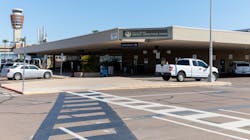To access different areas of the airport, different badges are needed.
For anyone at an airport who has an operational need to access a security identification display area (SIDA), a SIDA badge is required. This badge is typically issued to people who work beyond the screening checkpoint in the sterile area and includes baggage handlers who work on and around aircraft, among others.
To obtain a SIDA badge, applicants must pass a security threat assessment (STA) and a fingerprint-based criminal history records check (CHRC) as well as SIDA training. While a SIDA badge is required by the Transportation Security Administration’s (TSA) Airport Security Program, it is the airport operators that issue SIDA badges.
“The badge itself is very much an airport-specific issue,” says TSA press secretary R. Carter Langston, noting the role of TSA is to conduct vetting and background checks against FBI and law enforcement databases, as well as recurrent vetting for those who are badged.
To address risks associated with insider threats, TSA vets more than 25 million transportation workers daily against the federal terrorism watchlist. Transportation workers include airport workers, airline flight crewmembers, mariners, commercial drivers who haul hazardous materials and cargo screeners and handlers. Langston explains the aviation sector represents the vast majority of the transportation workers vetted by TSA.
Although airport security programs are regulated by TSA, there can be some variation among the airports, for instance, in how information is presented.
SIDA Badging at PHX
Phoenix Sky Harbor International Airport (PHX) described its badging process online during a virtual session of its 2022 Aviation Business Summit.
“The security badging process is the most important step you and your employees will take working at and with our airport,” says Shawna Larson, former deputy aviation director of safety, security and emergency preparedness programs at PHX, now assistant city attorney for the City of Phoenix.
At PHX there are about 18,000 badge holders, who Larson says are the airport's “eyes and ears each day.”
“‘See Something, Say Something’ responsibilities begin the minute you and your employees receive your airport badges,” she says.
Paul Berumen, special projects administrator, security and airport security coordinator – regulatory, says the airport is often asked why a badge is necessary.
Shortly after the September 11th terrorist attacks, Congress passed the Aviation and Transportation Security Act, creating the TSA and requiring fingerprint background checks of personnel that require unescorted access in the SIDA or sterile area.
“It’s a 10-year look back,” Berumen says, noting Congress also outlined the criminal offenses that would disqualify someone from being issued a SIDA badge. Of the 36 disqualifying crimes, Berumen says theft (felony) and sale of prohibited drugs (misdemeanor or felony) are among the most common.
Last year, TSA implemented the FBI recurrent criminal history vetting service known as “Rap Back” to provide near real-time notification of new, potentially disqualifying criminal events that enable TSA and airport and aircraft operators to revoke an individual’s unescorted access.
“That’s an additional check in which all of our badge holders will be in the FBI criminal history vetting 24/7,” Berumen says.
The Security Badging Office at PHX provides its business partners and their employees with badging and fingerprinting services. Existing companies who are enrolling new badge holders or renewing existing badge holders can use a secure online system.
New companies will need to visit the Security Badging Office and complete New Company Setup application forms.
All companies must have an “authorized signer” (AS) or point of contact between the badging office and the company’s employees or job applicants.
Berumen outlines several keys to success while working with the badging office. They include having a dedicated authorized signer (not someone assigned the responsibility as an additional duty), who is knowledgeable about the process, active and engaged with the airport and their company, and in regular communication with badge holders.
“We ask that you educate the applicants or your personnel on what to expect when they come to the badging office,” he says.
Kamila Kisova, aviation supervisor III at PHX, says the process starts with the AS submitting an electronic application to the badging office.
“It is very important that authorized signers pre-enroll or renew applicants and then advise the applicant or badge holder to schedule an appointment to come into the badging office,” she says.
To keep the process going smoothly, she says authorized signers should be sure to enter accurate data.
At the appointment, which takes about 15 minutes, the badging office will verify information – including ID, authorization to work, and that the applicant has read and understood the application forms and has no disqualifying crimes; scan documents; take fingerprints and collect payment. Once these things are done, a temporary badge will be issued for 30 days, which allows the applicant to begin working while escorted by someone with escort privileges.
After badging office submits paperwork to the FBI and TSA, Kisova says background checks typically take 7 to 10 business days.
Once the applicant’s background is cleared, training videos are sent to the applicant. The non-secure training online is followed by in-person security training at the badging office, which takes 1.5 to 2 hours.
Applicants have 30 days from the notification date to complete all training and have a badge printed. Airline-sponsored applicants are notified of this clearance through the airline.
Once all the steps are completed, the airport can issue a SIDA badge.
“Our business practices and fees may be different, but airports that issue SIDA badges have the same TSA regulatory requirement,” says PHX public information manager Tamra Ingersoll. “We are unique in that PHX issues a temporary badge, which allows the applicant to be escorted while they undergo the clearance process, and our (initial) training has been deemed to not be Sensitive Security Information (SSI), so training can be done remotely on our online platform.”
SIDA Badging at SEA
Seattle-Tacoma International Airport (SEA) has an educational image that illustrates the steps to apply for a new badge. Configured like a board game, each step has a link to more information.
Lauren Curtis, senior manager in aviation security, oversees the badging process at the Port of Seattle Credentialing Center.
If SIDA badge applicants need access to the international arrivals facility, there is a different application process for a customs seal. The U.S. Customs and Border Protection (CBP) office issues and manages customs seals for individuals requiring access to CBP security areas.
Not everyone needs a customs seal, but Curtis says a SIDA badge is required in order to get a customs seal. The security check goes through the credentialing center but is vetted by CBP, she adds.
The background process on average takes 2-4 days. However, foreign-born applicants typically see a 2- to 3-week delay in receiving a result.
“We have a very diverse badge population here, English is spoken as a second language for a good percentage of our badge holders,” Curtis says.
After the background checks are cleared, training can begin. If an applicant needs help preparing for SIDA badge training, Port Jobs, a contracted agency, offers preparation classes. They are in-person and about 2 hours long. Although the SIDA test is in English, the training helps people understand in their own native language what it means to get a badge and introduces security concepts such as SIDA, AOA (air operations area), the secured area, and terms like piggybacking and challenge.
“These terms are known in our industry and are required as part of the badge process,” Curtis says.
Once a badge is approved, employers cover the cost of the badge and the badge is good for two years.
“Everything is regulated by TSA,” Curtis says. “When you become a badge holder, you’re required to, for example, challenge somebody if you see somebody working inside the SIDA that doesn’t have a badge, you are responsible to say, ‘Where’s your badge?’ We’re audited by TSA every year. What we say at SEA is each badge holder are the eyes and ears of security. Everybody does their part to keep us secure.”






